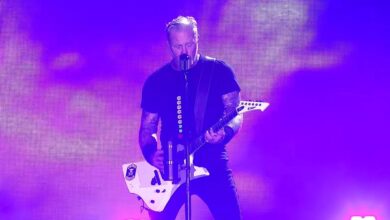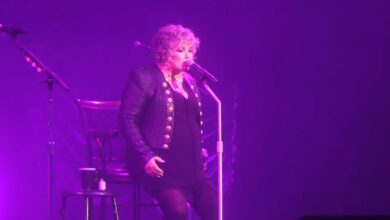Disturbed’s “Don’t Tell Me” Featuring Ann Wilson — A Haunting Fusion That Bridges Generations and Breaks Hearts Alike
On a cold January night in 2024, the lights dimmed and the members of Disturbed walked onto the stage with a sense of purpose. The crowd buzzed with expectation, unaware that they were about to witness a performance that would blur the lines between eras. The opening chords of “Don’t Tell Me” emerged quietly, tentative at first, before blooming into full, resonant strength. The moment Ann Wilson stepped into the spotlight, the atmosphere shifted. What began as a collaboration became something more—a meeting of two distinct generations of rock, bound by emotion and artistry.
David Draiman’s trademark grit met Ann Wilson’s crystal-clear power in a duet that felt almost cinematic. Their contrasting tones—his dark, commanding growl against her soaring, controlled resonance—created a vocal dance that electrified the room. Wilson stood poised yet commanding, stepping forward only when the melody demanded her presence. When their voices finally intertwined, the sound carried an almost spiritual charge. It was as if hard rock’s evolution had folded in on itself, uniting two timelines through one shared heartbeat.
The arrangement itself breathed differently than the studio version. Disturbed’s guitars thundered across the venue, yet moments of stillness were woven between the waves of sound. During the softer passages, the haunting echo of piano and strings surrounded Wilson’s voice like a halo, while Draiman’s tone receded, waiting for its cue to reemerge. Every rise and fall drew the audience deeper in, transforming the song into an emotional narrative instead of a mere live recreation. It was reimagined with nuance, not repetition.
As the performance unfolded, the energy inside the arena became almost tangible. Fans accustomed to Disturbed’s heavy edge now found themselves hypnotized by Wilson’s timeless command. When the spotlights softened to trace her movements, her voice filled every corner of the hall, shimmering above the dense rhythm section. Draiman and Wilson occasionally faced one another mid-song, exchanging glances that conveyed unspoken respect—a moment that cameras captured and fans would later replay endlessly online, calling it one of the purest exchanges in recent rock history.
Halfway through, the focus shifted entirely to Wilson as she delivered a breathtaking bridge. Her voice climbed with clarity and strength, holding the audience in rapt attention. Behind her, the band whispered in harmony, layering subtle echoes beneath her soaring lines. The transition back into Draiman’s section felt like a storm rolling back in after calm waters. When both voices finally met again in the last chorus, their fusion was thunderous, the tension resolving into unity—a musical dialogue between generations made flesh.
The night’s most unexpected moment came in a fleeting ad-lib. Wilson lingered on a single sustained note—an improvisation not heard on the studio track. The audience gasped, and Draiman instinctively matched her with a raw, echoing response. That exchange wasn’t scripted; it was pure instinct, a heartbeat of spontaneity that reminded everyone why live music endures. For those in the audience, it was a revelation—proof that even in the age of perfection, unpredictability remains rock’s most sacred gift.
When the final chorus exploded into a wall of sound, the entire arena rose to its feet. The last chord lingered longer than usual, as if the band itself didn’t want to let go. Applause turned into roars, with fans shouting both artists’ names. Draiman and Wilson exchanged a brief smile before embracing, their shared triumph mirrored by the crowd’s response. It wasn’t just admiration; it was gratitude—for witnessing a union that made vulnerability feel powerful again.
Behind the scenes, the energy was equally electric. Backstage, Draiman and Wilson shared laughter and disbelief at how naturally the chemistry had flowed. The band, elated by the crowd’s reaction, reflected on how seamlessly the emotional transitions had unfolded in real time. For Wilson, the collaboration was proof that passion doesn’t fade—it simply finds new forms. For Draiman, it reaffirmed that risk and honesty remain the lifeblood of rock, even decades after its golden age.
Music critics quickly took notice. Reviews praised the performance as a bold conversation between two generations rather than a mere duet. Commentators highlighted how Wilson’s refined phrasing added texture to Draiman’s rawness, creating emotional contrast without compromise. Some wondered whether Disturbed’s fanbase would embrace such vulnerability, while others hailed it as the band’s most mature evolution. The consensus, however, was unmistakable: the collaboration worked because it was fearless.
Online, the response was immediate and overwhelming. Fans flooded social media with clips, hashtags, and emotional reactions. Edits of Wilson’s high notes circulated alongside Draiman’s intense delivery, while threads dissected every glance and vocal run. Rock forums lit up with comparisons to legendary duets of the past, with many calling this one “the bridge between eras.” The performance didn’t just unite fanbases—it created new ones, weaving Disturbed’s edge and Heart’s soul into a shared identity.
In later interviews, guitarist Dan Donegan revealed that the song’s emotional depth came from personal loss and reflection. Having Ann Wilson embody that vulnerability, he said, gave the performance an authenticity that no arrangement could replicate. The band initially worried that her legendary voice might overshadow them, but the opposite happened—it amplified their message. Wilson, too, noted that working with Disturbed reminded her that the emotional core of rock remains timeless, even when the sound evolves.
Subsequent shows saw Wilson appear again as a guest performer, yet none carried the same sense of surprise as that debut night. Each performance evolved slightly—different phrasing here, a new dynamic there—but fans continued to reference the first as the defining version. Even bootleg recordings of that concert, captured on shaky phones, spread widely among fans, preserving the emotional weight that no studio production could quite match.
As the tour continued, the song began to evolve within the setlist. Lighting cues softened, harmonies grew more intricate, and transitions became more fluid. But despite refinements, the band refused to polish away the raw tension that had made the debut so unforgettable. They understood that the magic lived not in perfection, but in the unpredictable chemistry of two powerful voices daring to share the same space.
In a broader sense, the collaboration marked a pivotal point in rock’s ongoing conversation between generations. Seeing Ann Wilson—one of the genre’s foundational voices—stand shoulder to shoulder with Disturbed symbolized both continuity and renewal. It wasn’t nostalgia; it was evolution. For fans, it proved that passion and authenticity remain the true engines of rock music, regardless of the decade or style.
Months later, that night remained a touchstone for both artists and fans alike. In polls, “Don’t Tell Me” continued to rank among the most requested encores, and streams of the studio version surged again. Every replay seemed to carry echoes of that January evening—the harmony, the emotion, the shared breath between Draiman and Wilson. It was more than a song; it was a bridge across time, connecting generations through one unshakable truth: the power of a voice unafraid to feel.





